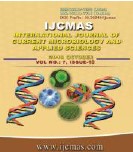


 National Academy of Agricultural Sciences (NAAS)
National Academy of Agricultural Sciences (NAAS)

|
PRINT ISSN : 2319-7692
Online ISSN : 2319-7706 Issues : 12 per year Publisher : Excellent Publishers Email : editorijcmas@gmail.com / submit@ijcmas.com Editor-in-chief: Dr.M.Prakash Index Copernicus ICV 2018: 95.39 NAAS RATING 2020: 5.38 |
The present study was undertaken to explore the immunological, antioxidant effect as well as microbial protein synthesis potency of oak leaves (Quercus leucotricophora) having 3.35% condensed tannin with its anthelmintic property. Twenty four local male goats of about 6-7 months of age were randomly divided into three homogenous groups (T1, T2 and T3) of eight animals each. Further, each group was subdivided in to 2 sub-groups of 4 animals each and one sub group in each group was treated with synthetic anthelmintic (Ivermectin @ 200µg/kg body wt.) (TA+). Experimental feeding was similar in the three groups except for the roughage source, which was local green grass (Pennisetum clandestinum) in T1A- and T1A+, oak leaves (Q. leucotricophora) in T2A- and T2A+ and oak leaves supplemented with PEG in group T3A- and T3A+, respectively. Microbial nitrogen (gd-1) was higher (P<0.01) in oak fed groups (T2A-, T2A+) than PEG supplemented groups (T3A-, T3A+) and grass fed groups (T1A-, T1A+). The IgG and IgA were decreased at 28th day PI and again improved significantly in groups treated with anthelmintic and group fed with oak leaves (T1A+, T2A-, T2A+, T3A+) while it decreased with PEG supplementation (T3A-) and lowest in the non-treated grass fed group (T1A-). The antioxidant property from GSH, SOD and catalase was significantly increased in oak fed groups (T1A+, T2A-, T2A+, T3A+) than grass fed groups (T1A-, T1A+). It was concluded that feeding of oak leaves having CT upto 1.6% in diet improved the microbial nitrogen supply, immunoglobulin status and antioxidant status of growing kids.
 |
 |
 |
 |
 |